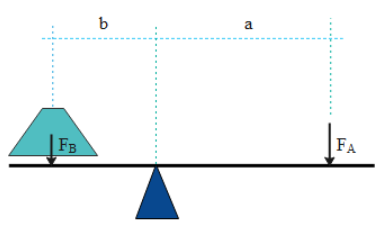
What is the effort required to lift a load $500N$ by using a lever with a mechanical advantage if it is $1.6$ ?
Answer
572.7k+ views
Hint: the force amplification achieved by using a tool or mechanical system is known as a mechanical advantage. This is modeled as the law of the lever. A lever as a rod that is capable of rotating on its axis.
As per the given data,
Output force is $500N$
Mechanical average is $1.6$
Formula to be used :
Mechanical advantage is given by
($mechanical\ advantage=\dfrac{output\ force({{F}_{A}})}{input\ force({{F}_{B}})}$)
Complete answer:
The device used in Mechanical advantage preserves the input power and trades off forces against the movement for the required amplification. Components of the machine which are used to balance forces and movement in this way are called mechanisms. An ideal mechanism transfers power without any kind of change in its value.
Now a day’s rotatory levers are widely used such as gears, pulleys, or friction drives in a mechanical power transmission scheme. The power into and out of the lever is always constant. The power is equivalent to the product of the force and velocity

Consider two points a and b which are at distances from the fulcrum to points A and B and if the force ${{F}_{A}}$applied to A is the input force and ${{F}_{B}}$ exerted at B is the output, the ratio of the velocities of points A and B is given by a/b so the ratio of the output force to the input force, or mechanical advantage.
Mathematically,
$mechanical\ advantage=\dfrac{{{F}_{B}}}{{{F}_{A}}}$
Where,
${{F}_{B}}$ Is the output force
${{F}_{A}}$ Is the input force
Now when we look at the situation given in the question:
$\begin{align}
& mechanical\ advantage=\dfrac{{{F}_{B}}}{{{F}_{A}}} \\
& \Rightarrow {{F}_{A}}=\dfrac{{{F}_{B}}}{mechanical\ advantage} \\
& \Rightarrow {{F}_{A}}=\dfrac{500}{1.6} \\
& \Rightarrow {{F}_{A}}=312.5N \\
\end{align}$
So the effort required to lift a load of $500N$ is $312.5N$
Note:
The lever is a movable rod that pivots on a fulcrum attached to or positioned at a fixed point. It works by applying forces at different distances from the fulcrum. The class of the lever is determined by the position of the fulcrum.
As per the given data,
Output force is $500N$
Mechanical average is $1.6$
Formula to be used :
Mechanical advantage is given by
($mechanical\ advantage=\dfrac{output\ force({{F}_{A}})}{input\ force({{F}_{B}})}$)
Complete answer:
The device used in Mechanical advantage preserves the input power and trades off forces against the movement for the required amplification. Components of the machine which are used to balance forces and movement in this way are called mechanisms. An ideal mechanism transfers power without any kind of change in its value.
Now a day’s rotatory levers are widely used such as gears, pulleys, or friction drives in a mechanical power transmission scheme. The power into and out of the lever is always constant. The power is equivalent to the product of the force and velocity

Consider two points a and b which are at distances from the fulcrum to points A and B and if the force ${{F}_{A}}$applied to A is the input force and ${{F}_{B}}$ exerted at B is the output, the ratio of the velocities of points A and B is given by a/b so the ratio of the output force to the input force, or mechanical advantage.
Mathematically,
$mechanical\ advantage=\dfrac{{{F}_{B}}}{{{F}_{A}}}$
Where,
${{F}_{B}}$ Is the output force
${{F}_{A}}$ Is the input force
Now when we look at the situation given in the question:
$\begin{align}
& mechanical\ advantage=\dfrac{{{F}_{B}}}{{{F}_{A}}} \\
& \Rightarrow {{F}_{A}}=\dfrac{{{F}_{B}}}{mechanical\ advantage} \\
& \Rightarrow {{F}_{A}}=\dfrac{500}{1.6} \\
& \Rightarrow {{F}_{A}}=312.5N \\
\end{align}$
So the effort required to lift a load of $500N$ is $312.5N$
Note:
The lever is a movable rod that pivots on a fulcrum attached to or positioned at a fixed point. It works by applying forces at different distances from the fulcrum. The class of the lever is determined by the position of the fulcrum.
Recently Updated Pages
Master Class 12 Business Studies: Engaging Questions & Answers for Success

Master Class 12 Economics: Engaging Questions & Answers for Success

Master Class 12 English: Engaging Questions & Answers for Success

Master Class 12 Maths: Engaging Questions & Answers for Success

Master Class 12 Social Science: Engaging Questions & Answers for Success

Master Class 12 Chemistry: Engaging Questions & Answers for Success

Trending doubts
The pH of the pancreatic juice is A 64 B 86 C 120 D class 12 biology CBSE

Which prominent US inventor was known as the Wizard class 12 social science CBSE

Which state in India is known as the Granary of India class 12 social science CBSE

Give simple chemical tests to distinguish between the class 12 chemistry CBSE

What is virtual and erect image ?

Explain the energy losses in the transformer How are class 12 physics CBSE




